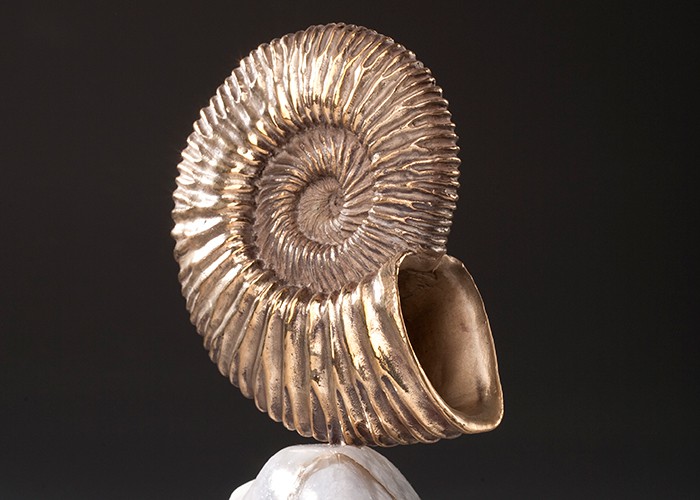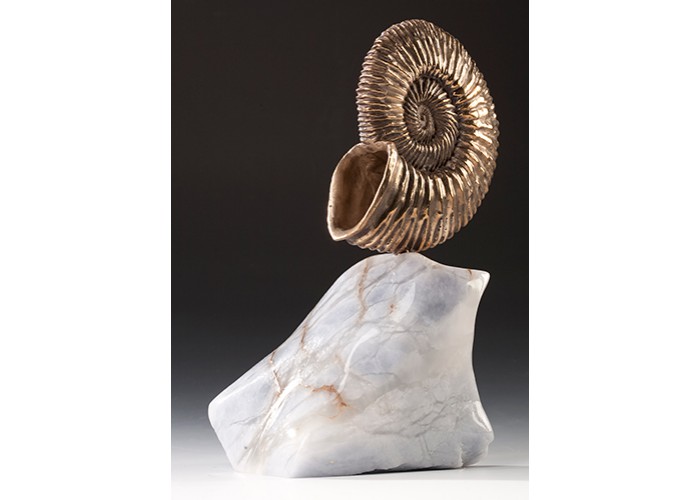Ammonite Shell
Ammonites are a group of coiled shelled cephalopods that lived in our oceans and seas during the Cenozoic Era. This was during the age of dinosaurs, at least it was on land, but in the oceans it was another story. In the oceans enormous marine reptiles like the ichthyosaur, the mosasaur and plesiosaur ruled. They along with Mesozoic sharks and other fish were the dominant predators of these ancient seas. So, what did they eat? Just like today, in our modern oceans where big fish eat little fish which in turn eat still littler fish the same was true then. One thing that made these seas different than those in our modern world was the presence of ammonites. As mentioned earlier these ammonites are coiled shelled cephalopods but what is a cephalopod?Medium – Cast bronze on a marble base
Dimensions – 6”H x 6"W x 2"D
Limited edition of 25 • Price $2,100
Cephalopods are mollusks that have legs. The word cephalopod actually means head –foot. These mollusks have tentacles (legs) of varying number radiating outward from around their mouth. Modern examples of cephalopods include the octopus, squids, cuttlefish and the nautilus. As groups they are intelligent, sophisticated predators of other creature in the ocean like small fish, crustaceans or other cephalopods. They range in size from the giant squid which reaches a length of about 45 feet and the giant pacific octopus with a maximum arm span of about 14 feet down to those species that full grown could easily fit in the palm of your hand. The only living group of cephalopods that have a shell today are the nautiloids but in prehistoric times there existed the ammonites.
Ammonite species number in the hundreds with more discovered all the time. In the Mesozoic seas they were incredibly common and are used by geologist as index fossils, which have to be very common and wide spread for a certain age in earth’s past. Just like the living cephalopods ammonites came in an incredible range of size and shell shapes. Some had streamlined narrow shells that would seem to allow fast movement through the water, some looked to have shells and a body shape that seem to indicate more of a planktonic existence and some with massive shells and size were probably benthic bottom feeding predators. The diversity of body size is also a reflection of the modern cephalopods. Some of the ammonites were small, just fingernail size while others have been discovered with shells 6 feet or more across. Their shells are plentiful in Mesozoic marine rocks but fossils showing the rest of their bodies are almost unknown.
In this sculpture, ammonite shell I used the shell from Ammonites of the Mesozoic to create a smaller stand alone piece. Surface textures of ammonite shells and the suture patterns that exist in the shell itself come in countless variations. The ripples on the surface of this sculpture and the coiling of the shell are based on actual fossils in the collection of the Cincinnati Museum of Natural History. This sculpture has just the bronze ammonite shell sculpture mounted on a piece of polished alabaster. A bronze shaft is welded to the base of the sculpture with a hole drilled down through the top of the alabaster. This allows the shell to be lifted out of the alabaster for closer observation as well as allowing the bronze shell to be rotated on its alabaster base to better suit the esthetics of the observer. Alabaster is a rather soft stone that comes in a variety of hues depending on what elements are present. Because of this the bases for these pieces are all one of a kind they are unique pieces, actually the stone is quite beautiful with the bases becoming works of art in their own right.
This sculpture will vary in weight and size with the variations in the stone base.
 Ammonite Shellcast bronze sculpture on alabaster base
Ammonite Shellcast bronze sculpture on alabaster base
 1
1 2
2